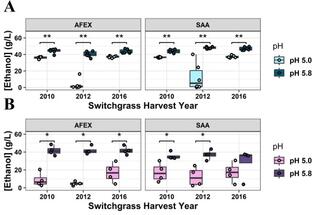pH adjustment increases biofuel production from drought switchgrass hydrolysate

Background/Objective
-
Switchgrass grown during drought conditions has high levels of osmoprotectant sugars and saponins that inhibit microbial conversion to biofuels. This experiment explored whether the inhibitory effect was specific to ammonia fiber expansion (AFEX) pretreatment and whether it could be alleviated by raising the pH of the hydrolysate.
Approach
-
Switchgrass samples from drought (2012) and non-drought (2010 and 2016) years were pretreated with two methods, AFEX and soaking in aqueous ammonia (SAA), followed by enzymatic hydrolysis. The pH of both hydrolysates was adjusted to 5.0 and 5.8, and the feedstocks were fermented by Saccharomyces cerevisiae and Zymomonas mobilis. Each microbe was also cultured in synthetic hydrolysates formulated with and without many lignocellulose-derived inhibitors at pH 3, 4, 5, 6, and 7.
Results
-
Fermentation rates and biofuel production from AFEX-and SAA-pretreated switchgrass hydrolysates from normal and drought years were higher at pH 5.8 than at pH 5.0 for both S. cerevisiae and Z. mobilis. SAA pretreatment of drought switchgrass enabled increased fermentation rates and titers compared to AFEX pretreatment. Experiments using synthetic hydrolysate showed increased biofuel production above pH of 5.0 resulted from relief from pH-dependent inhibition.
Impact
-
Results demonstrate that SAA pretreatment and pH adjustment can significantly improve fermentation and biofuel production from switchgrass hydrolysates, especially from drought-switchgrass hydrolysates. Overall, increased pH is the most promising method to overcome the inhibitory effects of drought-switchgrass hydrolysates on microbial fermentation.